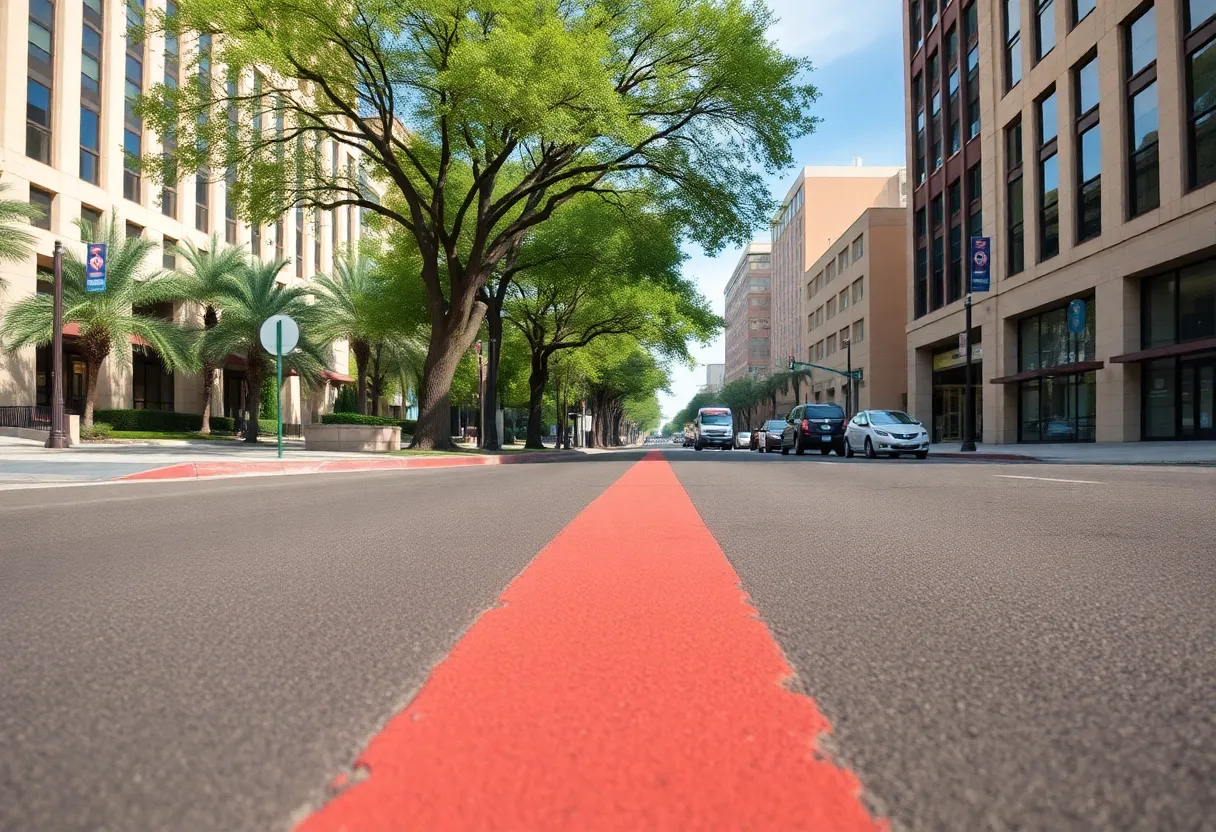News Summary
Phoenix is broadening its cool pavement initiative to tackle rising temperatures and mitigate the urban heat island effect. With nearly 5,000 miles of dark asphalt streets, the city sees increased heat-related health risks. The cool pavement, which reflects more sunlight and absorbs less heat, has been installed on 150 miles so far. Ongoing efforts aim to improve community comfort by integrating tree planting and emerging data-driven strategies to address extreme heat in vulnerable neighborhoods.
Phoenix is expanding its “cool pavement” program as part of ongoing efforts to combat rising temperatures and reduce the urban heat island effect. With nearly 5,000 miles of dark asphalt streets, Phoenix neighborhoods are experiencing higher-than-normal temperatures, contributing to an increase in heat-related health risks.
Cool pavement is a specially formulated coating designed to lower street temperatures by several degrees. As the program progresses, it aims to provide substantial relief in areas particularly vulnerable to excessive heat. Currently, the city has installed nearly 150 miles of cool pavement, with plans to continue expanding this initiative.
A specific location noted for the application of cool pavement is near the intersection of 19th Avenue and Camelback. The cool pavement coating has a lighter color and different texture compared to traditional asphalt, incorporating various pigments and materials engineered to reflect more sunlight and absorb less heat.
Studies reveal that the urban heat island effect in Phoenix results in nighttime temperatures that can be significantly warmer than the surrounding desert areas, with some neighborhoods being up to eight degrees hotter. To prioritize areas in greatest need, Phoenix officials are utilizing data to identify neighborhoods lacking shade where cool pavement could be particularly beneficial.
Residents, such as those living in regions heavily impacted by extreme heat, have expressed hopes for relief from the newly implemented cool pavement. Many recognize, however, that while this initiative can help, it is just one component of a comprehensive strategy needed to effectively reduce ambient temperatures throughout the Valley.
Since the start of the cool pavement program in 2020, the city has treated over 107 miles by fall 2021. Recent assessments reveal that the new CoolSeal 2.0 pavement coating has the potential to decrease surface temperatures by as much as 12 degrees Fahrenheit. Additionally, neighborhoods that have already benefited from cool pavement during heat waves recorded air temperatures approximately 3.5 degrees cooler than areas without it.
The lifespan of cool pavement is estimated to be around eight years, which is double that of traditional black seal coat that typically lasts about four years. This improvement may reduce long-term maintenance needs and associated costs for city roads by lessening thermal strain on the surfaces.
Nevertheless, some experts caution that while cool pavement can lower surface temperatures, it might also raise mean radiant temperature—which contributes to how residents perceive heat exposure. This could potentially lead to adverse effects, particularly in high pedestrian traffic areas, marking it as a possible “maladaptation.” Research indicates that the sensation of heat exposure tends to be higher over treated surfaces, especially during noon and afternoon hours.
A prior study has suggested that the impact of cool pavement on overall air temperatures may be marginal. More broadly, while cool pavement contributes to temperature reduction, experts recommend integrating additional shade solutions, such as tree planting, to further protect pedestrians from the heat and improve overall community comfort.
In conjunction with the cool pavement initiative, Phoenix officials are also focusing on planting trees to establish “cool corridors” throughout the city. With a goal of creating 100 cool corridors, this dual strategy aims to provide additional shade and enhance urban habitat while actively improving residents’ comfort levels during extreme heat periods.
While there is optimism surrounding the cool pavement program, some members of the community are expressing mixed feelings regarding its overall effectiveness. Concerns have been raised about whether financial resources might be redirected to other heat mitigation strategies that could yield greater long-term benefits. As the program continues, the city will need to evaluate its impact thoroughly against the backdrop of climate change challenges facing the region.
Deeper Dive: News & Info About This Topic
HERE Resources
Metro Phoenix Anticipates Light Showers and Thunderstorms
City of Phoenix Implements New Heat Safety Measures as Temperatures Soar
Additional Resources
- ABC15
- MSN News
- Smart Cities Dive
- KTAR
- AZ Family
- Wikipedia: Urban Heat Island
- Google Search: Phoenix cool pavement
- Google Scholar: cool pavement effectiveness
- Encyclopedia Britannica: cool pavement
- Google News: Phoenix heat management

Author: STAFF HERE PHOENIX WRITER
The PHOENIX STAFF WRITER represents the experienced team at HEREPhoenix.com, your go-to source for actionable local news and information in Phoenix, Maricopa County, and beyond. Specializing in "news you can use," we cover essential topics like product reviews for personal and business needs, local business directories, politics, real estate trends, neighborhood insights, and state news affecting the area—with deep expertise drawn from years of dedicated reporting and strong community input, including local press releases and business updates. We deliver top reporting on high-value events such as the Waste Management Phoenix Open, Cactus League Spring Training, and Arizona State Fair. Our coverage extends to key organizations like the Greater Phoenix Chamber of Commerce and Visit Phoenix, plus leading businesses in technology and healthcare that power the local economy such as Intel and Banner Health. As part of the broader HERE network, including HERETucson.com, we provide comprehensive, credible insights into Arizona's dynamic landscape.





